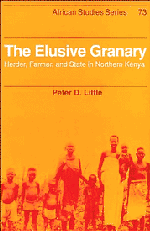Book contents
- Frontmatter
- Contents
- List of illustrations
- List of tables
- Preface
- 1 Introduction: the study of agrarian change among African herders
- 2 Society, ecology, and history
- 3 Markets and the state
- 4 Labor and agropastoral production
- 5 Income, wages, and investment
- 6 Expenditures, consumption, and the food crisis
- 7 Land conflicts and sustainability
- 8 In pursuit of the granary: development responses of community, donor, and state
- Notes
- References
- Index
- AFRICAN STUDIES SERIES
2 - Society, ecology, and history
Published online by Cambridge University Press: 04 August 2010
- Frontmatter
- Contents
- List of illustrations
- List of tables
- Preface
- 1 Introduction: the study of agrarian change among African herders
- 2 Society, ecology, and history
- 3 Markets and the state
- 4 Labor and agropastoral production
- 5 Income, wages, and investment
- 6 Expenditures, consumption, and the food crisis
- 7 Land conflicts and sustainability
- 8 In pursuit of the granary: development responses of community, donor, and state
- Notes
- References
- Index
- AFRICAN STUDIES SERIES
Summary
Important historical and ecological processes have shaped II Chamus society. The ecology of Baringo – characterized by well-watered highlands, lush swamps, and barren lowlands – figures strongly in the history of the region. The different ecological zones provided both opportunities and constraints to populations who migrated to the area. Located among prime wetland-grazing areas in the center of the Rift Valley, the II Chamus area in particular has played a pivotal role in the histories of both northern pastoralists, such as the Samburu and Turkana, and southern groups, such as the Purko Maasai (Anderson 1982; Sobania 1980; Waller 1985). In the nineteenth century the Baringo basin became the scene of important pastoral migrations and fierce warfare that caused social upheavals and discontinuities. At the same time, however, the breaking off of pastoral families and clans from the main groups that used the area intermittently, contributed to the growth of the II Chamus community. Thus, what emerged as the II Chamus is a mosaic of different ethnic groups and clans who either settled in the area or periodically used its rich resources.
Defining a meaningful region in northern Kenya requires placing it in a historical context that distinguishes carefully between the precolonial and colonial periods. According to Waller (1985), two large regional systems operated in the nineteenth century, incorporating many of East Africa's important pastoral and agricultural groups. The first was the central Rift Valley system that included the Purko Maasai and other Maa-speakers, including the II Chamus, as its geographic core, but also incorporated Kalenjin groups like the Tugen and Nandi, and such Bantu groups as the Kikuyu and Kamba.
- Type
- Chapter
- Information
- The Elusive GranaryHerder, Farmer, and State in Northern Kenya, pp. 17 - 39Publisher: Cambridge University PressPrint publication year: 1992



